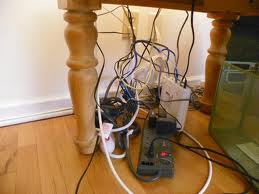 Electrocution is reducing as a cause of toddler injury largely due to statutory regulations governing switchboard safety devices.
Electrocution is reducing as a cause of toddler injury largely due to statutory regulations governing switchboard safety devices.
Switchboard
You should ensure your switchboard is protected with a Residual Current Device usually denoted on your switchboard as RCD unless specialised imported components have been used. This is an automatic shutdown switch that instantly detects a power purge and cuts power.
Older houses may not be equipped with an RCD but these can be retro-fitted by a registered electrician for as little as $250. This is crucial to toddler safety.
Power Points
Regardless of the presence of an RCD, power points should always be protected using plastic power point inserts.
Power Boards
Most homes require power-boards due to the proliferation of low current devices typical of our hi-tech era. Power-boards are easy for a toddler to access; therefore any unused terminals should be protected with plastic inserts.
A preferred option to this would be to replace power-boards with child safe models that deny access to the terminals as soon as a plug is removed.
Some toddlers develop a fascination with power switches. A reasonable resolution is to use a child safe power-board attached to a wall socket that is isolated by furniture.
Trailing Cords
Parents should be careful not to leave trailing appliance cords overhanging benches. Toddlers tend to grab onto items above their heads and if they dislodge a heavy appliance or worse still a kettle of boiling water they could cause permanent injury.
Excessive Cords
The proliferation of computer and hi-fi equipment present in most households usually results in an excess of loose cords. Where possible isolate cords behind furniture or bundle them together using a proprietary wiring loom to avoid the possibility of strangulation.
Blind Cords
From 2009 all new blinds must be installed with cords restrained to the wall or window architrave.
Accessible blind cords have been responsible for many instances of strangulation. Low level looped cords are particularly dangerous for obvious reasons. Many parents are satisfied if loops are out of toddlers reach, however care must be taken to ensue that subsequent moving of furniture does not render cords accessible. A chair or couch near a looped cord could be fatal. Never position a cot within reach of blind cords.
Blind cords that are not secured can be easily addressed by hanging the cord on a self adhesive hook positioned high on the window architrave.
Cords with a pulley weight can be as dangerous as loose cords. A small screw eye positioned in the bottom of the weight will allow it to be positioned onto a hook located on the window architrave.
Sharps
Many toddlers are hospitalised from injuries sustained in falls against sharp furniture corners, fireplace hearths or tiled bath surrounds.
Corner protectors are readily available but rarely provide satisfactory protection. Most corner protectors are moulded from a semi-soft plastic similar to the material teething toys are made from. The adhesive is weak and therefore they are easily removed by an inquisitive toddler.
Homesafekids uses a low density foam cushion that is larger than most available and therefore offers a greater degree of protection. This also provides a larger bearing surface and subsequently better adhesion.
Glass
Each year in Australia approximately 38,000 children visit hospital emergency centres with glass related injuries.
Low Level Windows
Older houses with low level windows, particularly those built in the 70’s and 80’s will almost always have extremely fragile glazing. Where there is space in front of the window for a toddler to run, there is an ever present danger of serious glass injury.
Windows can be re-glazed or an inexpensive alternative would be to install security film. This is a 7 micron film that is applied to the window and will prevent any penetration of the glass. The glass can break on impact but the shards will remain in place preventing injury. HomesafeKids has many client testimonies of windows with safety film being broken by a young child with no resulting injury.
Low level window glass in modern houses must, by law be safety glass however there are still instances where unscrupulous builders will specify standard float glass to gain a tender advantage. Tempered safety glass will display a discrete insignia fired into one corner. If this does not appear it is quite possibly laminated safety glass that has no visible marking. Measuring the glass thickness will give some clue as to its construction. For example 4 mm thick glass will most likely be laminated glass constructed from 2 sheets of 2mm. Whereas 3mm glass will almost definitely be float glass and extremely dangerous.
Products
Glass products such as bottles, bowls, saucepan lids etc. can cause severe glass cut injuries. Always ensure that these items are located well out of reach of toddlers or in latched cupboards particularly where hard floors will result in glass smashing.
Ornaments
Glass ornaments should never be located in areas where toddlers are prone to play. They may look attractive but could cause severe injury if they break. You should avoid small goldfish bowls located on accessible tables as these can attract toddlers.
